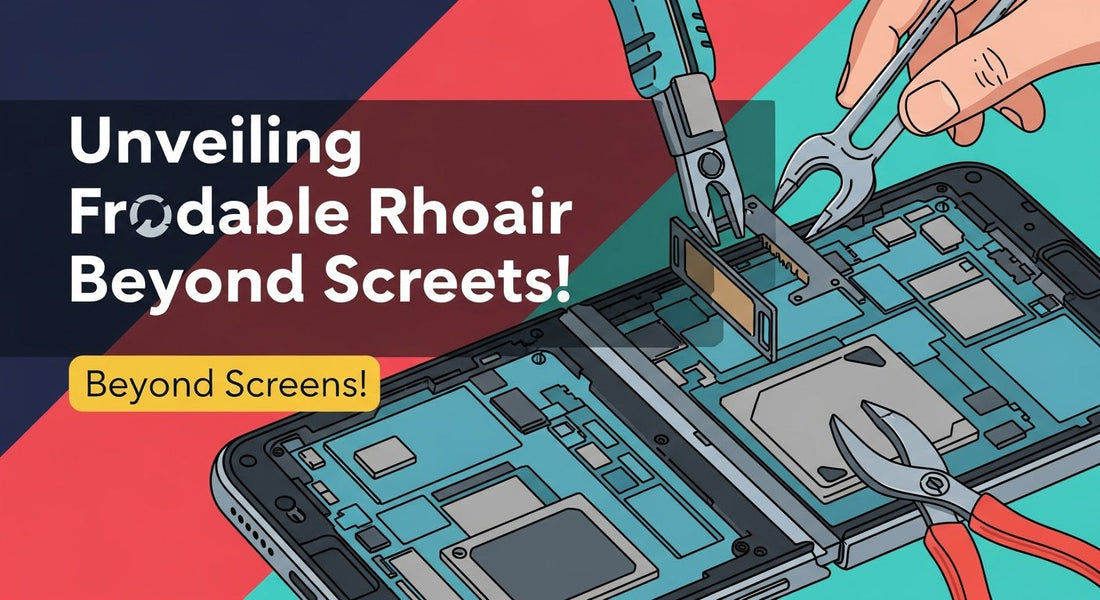The rise of the foldable smartphone—a category spearheaded by devices like the Samsung Galaxy Z Fold and Z Flip series—represents one of the most significant leaps in mobile technology. These devices successfully merge the utility of a tablet with the portability of a standard phone, offering users a vast, flexible display and a powerful dual-app experience.
This convergence of form factors demands cutting-edge engineering, utilising sophisticated, multi-part designs that are fundamentally different from traditional glass slab phones. Their construction often involves aerospace-grade materials, complex ribbon cables that cross the central axis, and dual batteries to power the larger screen area.
🤔 However, this revolutionary design introduces unique vulnerabilities and repair complexities that go far beyond a simple cracked outer screen.
![]()
While display damage is certainly common, an expert repair centre understands that the true secrets and challenges of foldable phone repair lie deep within the mechanical and structural components.
The Intricate Fail Points: Hinge, Flex Cables, and Structural Integrity
When a foldable device sustains damage, technicians at Sydney CBD Repair Centre know to look immediately past the display surface and focus on the internal architecture. The central point of vulnerability is invariably the Hinge Mechanism. This component is the engineering marvel that allows the device to function, but it is also a highly delicate system composed of dozens of micro-parts, including interlocking gears and fine brushes designed to repel dust and debris.
- Hinge Failure: This is arguably the most common non-screen fault. A drop or simple wear and tear can cause the hinge to stiffen, refuse to lock into the fully flat position, or even fail to close completely. Sand or fine dust intrusion, even with modern ingress protection ratings (like IPX8), can degrade the internal brushes, leading to a grinding sensation or physical damage to the inner display assembly due to internal friction. Hinge repair is an intensive process, often requiring the replacement of the entire mid-frame assembly to guarantee factory-level alignment and tension.
- Internal Flex Cables: Unlike a regular phone, a foldable must route power, display data, touch input, and sensor data across the fold. This is done via ultra-thin, highly flexible ribbon cables. If the device is dropped or folded beyond its intended limit, these internal flex cables can tear or become damaged where they cross the hinge point. This often results in a partially or completely black inner screen, flickering, or a complete loss of touch functionality along the crease, even if the OLED panel itself appears physically intact.
- Dual-Battery Configuration: Most foldable phones utilise two separate batteries—one in each half of the device—for optimal weight distribution and space utilisation. Replacing these batteries is a significantly more complex operation than a standard smartphone, as it requires careful disconnection of flex cables routed near or through the hinge to access the power cells in both halves without causing further damage.
Why Specialist Foldable Repair is Non-Negotiable
Attempting a DIY repair on a foldable phone is extremely ill-advised. The risk of permanent damage far outweighs any potential saving due to the precision required.
- Specialised Tools and Environment: Foldable disassembly requires precision heat application, proprietary jigs for alignment, and specialised non-marring tools to separate adhesive-heavy components without stressing the flexible display.
- Calibration: A professional repair is often more than just a component swap. After a hinge or main display replacement, the device may require a manufacturer-specific software calibration procedure to ensure the phone registers its open and closed states correctly and maintains the intended folding tension.
- Preserving Water Resistance: The factory water-resistant seal (like the IPX8 rating on many Samsung models) is compromised the moment the device is opened. Only professional service centres, using OEM-specification adhesives and resealing techniques, can restore this protection to its original level.
Key Takeaways for Every Foldable Phone Owner
The innovation of foldable phones comes with an increased level of repair complexity. Understanding the hinge mechanism, the role of internal flex cables, and the structural integrity of the frame are essential for diagnosing and successfully repairing these cutting-edge devices. While a cracked screen is a clear problem, issues like a stiff hinge or flickering inner display are often indicative of a deeper, more challenging structural or internal component failure.
If your foldable device begins to exhibit any unusual folding resistance, screen flickering along the crease, or battery drain, do not delay. Trusting your valuable investment to non-specialised repairers is a major risk. At Sydney CBD Repair Centre, our technicians are trained and equipped specifically to handle the unique mechanical and electronic architecture of foldable devices, ensuring that every hinge, flex cable, and display is replaced or realigned with factory-level precision, restoring your phone's functionality and its IP rating.
People also search for:
Foldable phone hinge repair Sydney cost
Samsung Z Fold 5 inner screen flickering fix
How to fix a stiff foldable phone hinge
Foldable phone flex cable replacement price
Galaxy Z Flip structural damage repair
Non-screen issues on foldable phones
Z Fold dust damage repair
professional foldable battery replacement

